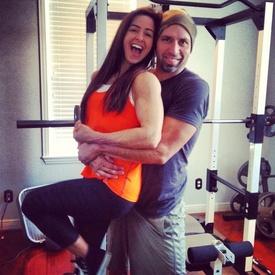
by | Apr 15, 2014 | Building Muscle, Cardio, Consistency, Fat Loss / Cutting, Transformations
 If someone would have told me 20 years ago that I needed to increase my caloric intake by 30% to lose body fat, I would have laughed while continuing to lace up my Mizuno running shoes preparing for my hour long run. Now 5 kids later, a little older and a little wiser, with decades of trial and error underneath my belt, eating more to weigh less has been a key factor in my fitness journey.
If someone would have told me 20 years ago that I needed to increase my caloric intake by 30% to lose body fat, I would have laughed while continuing to lace up my Mizuno running shoes preparing for my hour long run. Now 5 kids later, a little older and a little wiser, with decades of trial and error underneath my belt, eating more to weigh less has been a key factor in my fitness journey.
A common misconception among those that want to lose weight is that you need to drastically cut calories and increase cardio workouts. This problematic approach has resulted in many trying to lose weight to only damage their metabolism. I speak on this issue not only from reading other stories, but I have personally experienced this metabolic damage which resulted in a serious health issue called Adrenal Fatigue. After everything I have learned, when I log onto My Fitness Pal and I see I see others eating 1200 calories with high calorie burns, my instincts are to immediately say, “Stop! Don’t do what I did.” As a longtime “My fitness pal” member, I recall an honest pal, Becca, specifically sharing this very concern with me that I was exercising too much, and not eating enough calories. Initially, for many weeks, I held onto the fallacy that I would attain my dream body while continuing on this path of destruction.
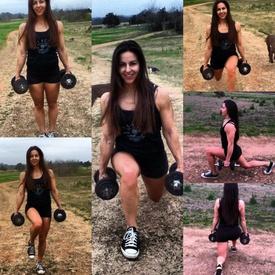 It was not until “my plan” to reach my “goal weight” by my 38th birthday came to a halt when my body reached homeostasis. I had reached a plateau in my weight loss journey and I was no longer losing fat, or gaining muscle. I was starving, exhausted and my body was at a complete standstill. Exasperated and feeling defeated, I went back to the drawing board to research fat loss remembering all the while Becca’s encouragement to eat more. Becca introduced me to a website for calculating calories. After spending some time on this website, I was shocked at the advice given. Based on my height, weight and activity level, I needed to be consuming 30% more calories. This line of thinking was so shocking and it went against every principle “I thought” I knew about losing weight.
It was not until “my plan” to reach my “goal weight” by my 38th birthday came to a halt when my body reached homeostasis. I had reached a plateau in my weight loss journey and I was no longer losing fat, or gaining muscle. I was starving, exhausted and my body was at a complete standstill. Exasperated and feeling defeated, I went back to the drawing board to research fat loss remembering all the while Becca’s encouragement to eat more. Becca introduced me to a website for calculating calories. After spending some time on this website, I was shocked at the advice given. Based on my height, weight and activity level, I needed to be consuming 30% more calories. This line of thinking was so shocking and it went against every principle “I thought” I knew about losing weight.
I even approached my husband with my concerns asking his advice. With the research I had been doing, along with the advice given by Becca and Kiki, it was evident a metabolic reset was necessary. In terror, just 3 weeks away from attempting to reach my birthday goal, I began reverse dieting adding 50-100 calories weekly to reach my Total Daily Energy Expenditure (TDEE). At this time I also implemented a plan to strategically count my macros. I pay close attention to the number of grams of proteins, carbs and fats I intake daily. From my research, the keys to cutting body fat are increasing calories while counting macros, reducing cardio, and increasing my weight lifting.
Well, my 38th birthday came and went. The scale never reached the number in my head, but my goal had changed during this time. I was determined to be fit and healthy versus being skinny. I continued on the metabolism reset with correct macros and increased calories while simultaneously reducing my cardio, and lifting heavy weights.
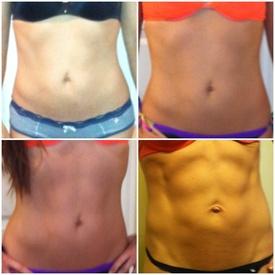 The number on the scale temporarily went up, but then my weight leveled out. One of the first physical changes I observed was my lack of hunger, increased energy level as well as the change in my body composition. My cellulite and fat began to diminish and I could see I was building muscle to form shape to my body. These major changes finally allowed me to feel more comfortable with my body.
The number on the scale temporarily went up, but then my weight leveled out. One of the first physical changes I observed was my lack of hunger, increased energy level as well as the change in my body composition. My cellulite and fat began to diminish and I could see I was building muscle to form shape to my body. These major changes finally allowed me to feel more comfortable with my body.
Although, I agree with counting your macros daily food intake, I am not a fan of “If It Fits Your Macros” simply because many will eat pop tarts, snickers bars, and a bag of chips, if it fits their macros. Although, I do have a weekly cheat, I attempt to eat real whole foods. Food is fuel. As a general rule, I stay away from processed foods, which means making time for prepping meals. With a large family to take care of and working 30+ hours weekly planning meal prep time is just as important as planning my workouts.
I am a homeschooling mother of 5, and I hold a 30+ hour job outside of the home. I make time for heavy lifting 5 days a week along with meal planning. This is not a New Year’s Resolution. This is mine and my husband’s lifestyle. My continued love for fitness has propelled my desire to become a certified personal trainer to continue to learn about fitness while helping others achieve their fitness goals.
Don’t give up on your fitness goals. I believe that anyone who truly wants to be fit and healthy will make the time. There is no secret pill or supplement. Hard work and dedication will help you get to your desired level of fitness. I know the proposition of adding calories for weight loss seems improbable, but I am living proof that it works.
If you are inspired by Tracy’s amazing story, make sure to follow her on Instagram!
 Becca is a busy wife and homeschooling mother to five children ages 5 to 13. About three years ago, she embarked on a journey to health and fitness that resulted in the loss of approximately 100 pounds. Today, she is a competitive powerlifter and strongwoman who loves ice cream and deadlifts. As an ISSA certified personal trainer, she is passionate about helping women to get started on a lifestyle of strength and fitness.
Becca is a busy wife and homeschooling mother to five children ages 5 to 13. About three years ago, she embarked on a journey to health and fitness that resulted in the loss of approximately 100 pounds. Today, she is a competitive powerlifter and strongwoman who loves ice cream and deadlifts. As an ISSA certified personal trainer, she is passionate about helping women to get started on a lifestyle of strength and fitness.
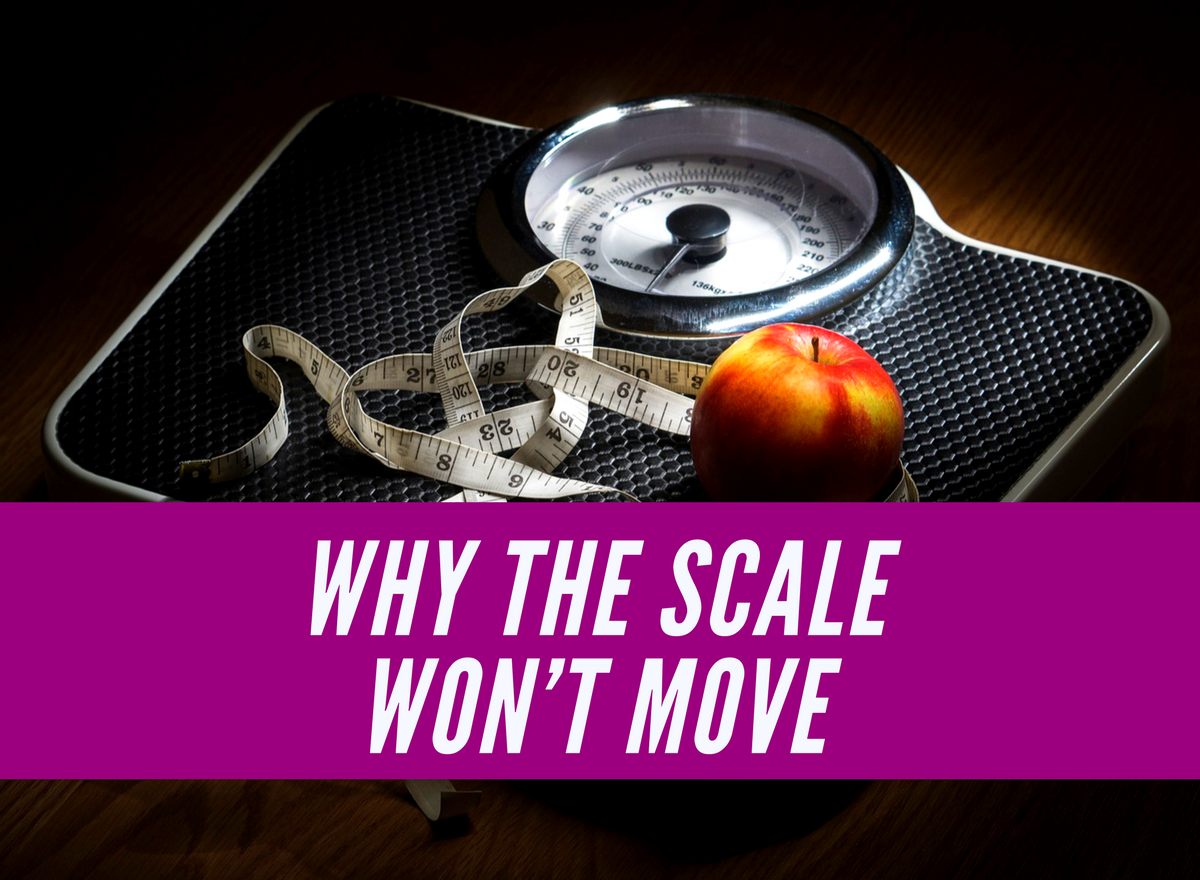
by EM2WL | Mar 26, 2014 | Fat Loss / Cutting
Ever wonder why it gets harder and harder to lose weight? Or why you’re finally doing it the right way, but the scale just won’t move?
Dieting… Why is it so hard?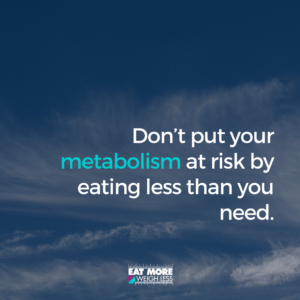
The more you diet, the less likely you are to lose weight – because you lose muscle and gain fat repeatedly — ultimately crashing your metabolism. Some studies have shown that for every 13 pounds lost on a traditional, low-calorie/high cardio diet, six pounds of muscle is lost. That’s almost HALF. In case you didn’t know:
Muscle = metabolism
This means that the more you lose, the slower your metabolism is. Then when (not if) you regain – you gain back FAT ONLY. Every time this process repeats, the fat percentage becomes higher than it was before, while muscle mass drops lower. So, even if you are the same weight you used to be, you’re technically “fatter.” If your weight is higher than it used to be, it begins to seem almost impossible to get the weight off. In some cases, it actually is impossible — if not futile — considering the loss of muscle mass and resulting metabolic crash.
After going through several diets, our goals must change. No matter how much you weigh – the goal (whether you realize it or not – your body does) becomes to “bulk” and build muscle to replace what was lost. Even if you ignore this fact, and attempt to start cutting the right way (eating a proper amount of calories and including some lifting) – your body still wants and needs to do this. When weight training during dieting – even if you’re in a deficit – you WILL gain muscle to replace what was lost. This means that you could sit at an extreme standstill on the scale, until your body has replaced every.morsel.lost… Remember that the scale does not tell the whole story.
Some women may only lose four pounds, yet drop two jean sizes; others may gain several pounds, and drop the same amount on the jeans. Although this is a more than nerve-wrecking experience, STAY.THE.COURSE. Because your only alternative, is to repeat the above course of action – and end right back at square one…gaining MORE fat.
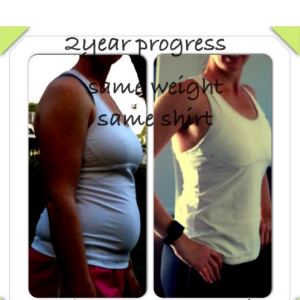
Terrianne hadn’t seen any progress…based on the scale ;) ~Check out her story!~
Still not convinced? This study goes into extensive detail about how each diet leaves our body with less of the metabolism boosting muscle that we need. For those not interested in the 97 pages of details, here’s the meat: women will lose muscle naturally (23% in women between ages 30-70), if they do nothing to preserve it. Diet + cardio = muscle loss (68% fat, 22% muscle). Diet + LIFTING = 97% fat loss, and only 3% muscle loss. Big difference? We think so. When you truly grasp how the fat continually increases (while the muscle stays the same or lessens) between diets, you’ll understand how we diet all our lives, yet end up bigger. Doing it right is so hard to wrap our brains around, but I’d rather have 97% fat loss over 68%. How about you?
So…Is there any hope?
Many women hear of the harmful effects of the dreaded yo-yo diet and throw their hands up in frustration. They either decide that eating properly isn’t worth it, so they go back to overeating (drowning sorrows) or undereating (back to the diet comfort zone). With all this bad news, they feel despair over their hopeless metabolism, and reaching their fat loss goals.
There’s always hope!! You simply have to be JUST as patient with doing things the right way as you were with the quick fixes.
We’ve trained ourselves to have much more faith in doing whatever it takes when the process is quick. Yet our faith wavers when doing the right thing takes “too long.” It really becomes about not looking for the same measures of success that you have in the past, and not putting yourself on those same timetables. Something is always happening, but the amount of patience that we have, and stress that we put ourselves through will come into play. I tell clients that taking on fat loss in the right way – after years of doing it the wrong way – is like going to college. Every time you doubt the process and change something up (unnecessarily) it’s like changing your major mid semester — you add more time to your journey. More time is lost in this process due to the wavering of trust, than to the actual length of time it may have taken with a tad consistency. Add stress/cortisol to the mix, and it’s like taking a full semester (or two…or three) off. Stressing about your journey, and changing things up constantly to make things happen more quickly, usually hurts more than it helps. It never makes them actually happen more quickly (you either stand still or head backwards). Stay the course. Again – it’s tough, but the alternative is worse.
But what if you can’t lift?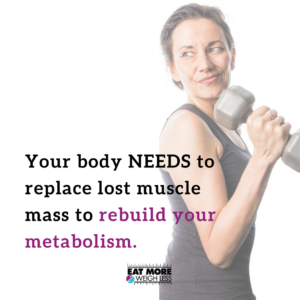
Some clients feel hopeless because they have limitations that keep them from being able to lift heavy enough. We are not talking mindset limitations, like “I’m too old/young/fat/skinny, etc…” Those would be considered excuses, not limitations. But others of us may have actual physical limitations, or injuries (permanent or temporary) and doctors orders to not do certain movements. If this is you, you have to work with what you have. Not everyone can lift heavy. Heck, I (Kiki) couldn’t for the past year, due to injury. If the situation is temporary, then keep your protein in check, allow yourself to fully heal, and get back to it when you can. All you can do is the best you can do. Don’t put yourself at risk by taking on more than you can, and don’t put your metabolism at risk by eating less than you need. The healing process is worth it in the end. You’ll be able to lift soon enough (although I personally know how hard it is to wait).
If the situation is permanent, then much of the above still applies. Finding ways to add resistance that works for you will be your key. Just find ways of putting as much resistance on the muscle as you can to maintain what you do have. Feel free to contact us if you need help, putting together a personalized plan for your circumstances.
Feel like you’ll NEVER see changes?
Sometimes it’s really hard to see changes in ourselves that are so obvious to others. My husband, family and friends always see changes in me before I “allow” myself to. My first instinct is to deny that anything is happening until he says it about three to four times…or until someone else says it. Remind yourself to take compliments at face value. Most people have nothing to gain by telling you that “you look amazing” or “like you’ve lost tons of weight.” Instead of saying “no I haven’t” followed by some negative retort (because of your own inner scale struggle), train your mind to just accept that they likely see something that you haven’t allowed yourself to see yet. Take a few moments to allow the compliment to sink in — and remind yourself of it every time you cross paths with a mirror, until the next compliment rolls in (or you find a new one to give yourself).
Learn to see yourself as (or better than!) others do, rather than constantly being your own worst critic.

by Trish Adams | Mar 20, 2014 | Fat Loss / Cutting, Nutrition, Stress
Several years ago when I decided I wanted to live a healthier lifestyle, I thought of all the things I would change. Things like never eating sugar, actually anything white got the axe, except for egg whites and cauliflower. I subscribed to Clean Eating magazine and vowed that I would cook all my meals and never step foot in my company cafeteria again. For the most part, I decided eating out basically had no place in my new lifestyle.
Eventually I stopped going out to eat altogether or, when I did, I smuggled in my own food. Yep, I brought my Rubbermaid to restaurants. I even started turning my nose up at going to dinner at friends’ homes. After all, they didn’t eat like I did, or heaven forbid, steam their vegetables.
 Looking back, you might say I was a bit neurotic and I would wholeheartedly agree. The truth is, I was trying to control every aspect of my diet, but it was a joy-sucking chore and the worst part was that it was unnecessary. I tried to control every element of my diet and it was depressing.
Looking back, you might say I was a bit neurotic and I would wholeheartedly agree. The truth is, I was trying to control every aspect of my diet, but it was a joy-sucking chore and the worst part was that it was unnecessary. I tried to control every element of my diet and it was depressing.
Oh, I felt accomplished, but now I realize that I really was deprived. I missed out on sharing good times and meals with friends and family and even potential professional opportunities as I especially steered clear of work outings. I must admit, I’m still not too fond of the office cafeteria, but when the odds of you getting food poisoning aren’t in your favor, you would be too.
When you decide that you’re going to adopt a healthier lifestyle, you may think you need to forgo eating out, because staying at home gives you more control over what you eat.
But dining out is about so much more than just the food. Don’t miss out on socializing with friends, panicking over what to eat when you’re traveling or just enjoying a night off from cooking.
Pull up a chair. Take a taste. Come join us. Life is so endlessly delicious.
― Ruth Reichl
Stress free eating out is enjoyable, and with a few tips, it becomes no big deal.
Plan ahead

Save room for the good stuff!
When dining at a new restaurant, go online to check out the menu. This will help set you up for success. Knowing what you’re going to eat when you walk in the door or having narrowed down the selection to a few choices ensures that you have thought through your meal and it will be more balanced than, say if you just ate on a whim. Figure out where your protein, fat and carbs will come from. If there’s a dessert that you really want to try, you’ll know not to dive into the bread basket or load up on a side of mash.
Mind Your Portions and Macros
If you are an avid calorie counter and tend to weigh your food regularly, you probably have a good sense of what your portion sizes are. This can get a bit trickier as you move away from calorie counting, but it’s nothing to worry about. Take notice of the portion size of food you eat when at home and simply eat to the same scale when eating out and take the rest home for lunch the next day.
For the intuitive eater, you probably already have a system in place for managing your portion sizes and macros. As a general rule I eat about 1-1/2 palm size of protein, ½ palm of fat, a fist of starchy carbs and as many veggies as I want. This can be adjusted depending on current goals, but in general, this is what I do. Over time this just becomes a habit and pretty much effortless whether eating at home or away. It’s also portable!
Another great tip whether eating at home or out on the town is to eat your food slowly. It takes about 20 minutes for your brain to send out satiety signals. Slowing down your eating will allow you to stop eating before getting over full. Plus, if you’re enjoying a splurge, why not savor each and every bite?

Chicken Tikka Masala – Yummm!
Watch Out for Sneaky Calories
What sounds like a pretty healthy meal can actually turn out to be a calorie bomb. Stay on the lookout for dishes that have sauces or are creamed, crispy, breaded…you get the idea. Not that you have to steer clear all the time, but know what you are eating. Of course beverages like soda, juices, lemonades, etc., unless they have a sugar substitute, are usually packed with calories as well and probably should be avoided in general. Opt for sparkling water or unsweetened tea instead.
Eating Out Mindfully and Stress-free
To sum things up, if you eat out regularly or travel a lot, aim to eat a bit closer to what you would normally eat at home most of the time. Over indulging on the regular won’t help you reach your goals and will probably just lead to a lot of frustration.
If you eat out a bit less frequently and want to splurge, go for it. If you happen to be going to the restaurant that makes the best vodka sauce in town, enjoy! I am a sucker for chicken tikka masala and make a point to get to my favorite Indian restaurant every now and again. It is definitely a splurge as not only do I eat the tikka masala, but I sop up the sauce with naan as well!
A splurge once in a while will have minimal impact on your progress when looking at the bigger picture, but may do wonders for your soul! Don’t miss out on the simple yet fulfilling things by limiting your diet to only what is prepared by you. Get out and enjoy life!
Photo credit: stockimages, kimberlykv, preppybyday
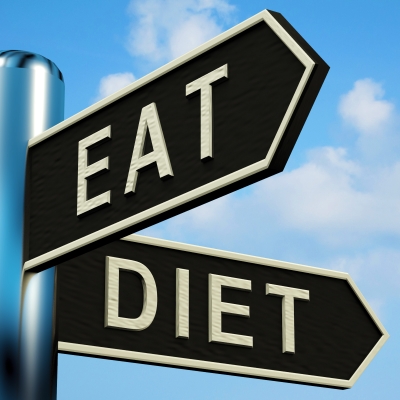
by Trish Adams | Mar 14, 2014 | Fat Loss / Cutting, Nutrition, TDEE/BMR, Troubleshooting
With the onset of your cut, it’s important to remember that it is just another phase of your fitness journey. Another step along a journey of many steps. As fat starts to shed it may be tempting to stay in this phase for the fat loss benefits. But rest assured, you’ll find that over time if you cut too long or too deep, it will work against you rather than in your favor. So, what to do? Cue the diet break.
As the name suggests, a diet break is just that, a break from your diet and a return to maintenance or eating at TDEE. Diet breaks can come in several forms, from simply a cheat meal or a refeed day to a full diet break which can last for a couple of weeks.
 WHY ARE DIET BREAKS NECESSARY
WHY ARE DIET BREAKS NECESSARY
During your cut phase, cals are adjusted slightly below TDEE with a 5-15% deficit. When cals are reduced, your metabolic rate slows to accommodate the decreased intake. Similarly when fat loss or weight loss occurs, your metabolic rate can also be impacted. This slowing of the metabolic rate can, in turn, slow your fat loss. Quite the vicious cycle, I know. To add further insult to injury, if you stay too long in a deficit, your body will start to adjust and think your deficit is actually your new maintenance. When fat loss stalls you may instinctively want to decrease calories further, however, this could potentially do more harm than good. By taking a diet break, you help return your metabolic rate to normal as well as your hormone levels, all of which will aid the fat loss process once you return to eating at cut. Additionally, a diet break can also serve as a psychological break if you struggle with sticking with your plan.
WHEN TO TAKE A DIET BREAK
Diet breaks should be planned anywhere from 4-12 weeks of your cut phase and should last for 1-2 weeks. If you have a vacation, special occasion or even a stressful time ahead, this would be the perfect time to write a diet break into your schedule. After all, if you’re vacationing you’ll probably want to kick back, loosen up the diet strings a bit and enjoy a little indulgence. Why fight it? The same can be said for times of stress. Scheduling a diet break might lessen the load slightly.
 HOW TO DO A DIET BREAK
HOW TO DO A DIET BREAK
As already mentioned, a diet break is a return to maintenance calorie intake. If you’ve adjusted your macros during your cut, you’ll want to return these to maintenance levels as well. Carbs are generally the most manipulated macro during cut, so be sure to bring this back to normal. As usual, your protein shouldn’t change much and should be at least 1g/lb bodyweight. Although cut phases should never be overly restrictive, if you are cutting back on any foods or macro groups, this is a great time for a comeback! Now, a diet break should not be confused with a free for all or an excuse to visit your local all-you-can-eat buffet. Stick to your maintenance cals and macros and you’ll do fine.
BONUS

Interestingly you may find that as you increase your cals for your diet break you may experience a whoosh or drop on the scale. This whooshing affect may be the result of water being released from fat cells which previously stored fat. You may also find that during your cut phase you weren’t able to perform as well with some lifts due to the reduced cals and possibly lower carbs. If that was the case, you should find your strength return to normal during the diet break and return to maintenance cals and macros.
There are many reasons to incorporate planned diet breaks into your nutrition plan. From a physiological perspective, the full diet break is recommended as it allows your body to return to normal levels, which in turn can aid your fat loss efforts. From a psychological perspective, it’s just nice to return to maintenance eating for a little while. With that said, it is strongly recommended for anyone doing a cut phase to include a full diet break at least every 12 weeks, if not more frequently, into your plan. While it seems counter-intuitive, trust that it will work in your favor in the long run.
Photo credit: stuart miles, Serge Bertasias Photography, stockimages
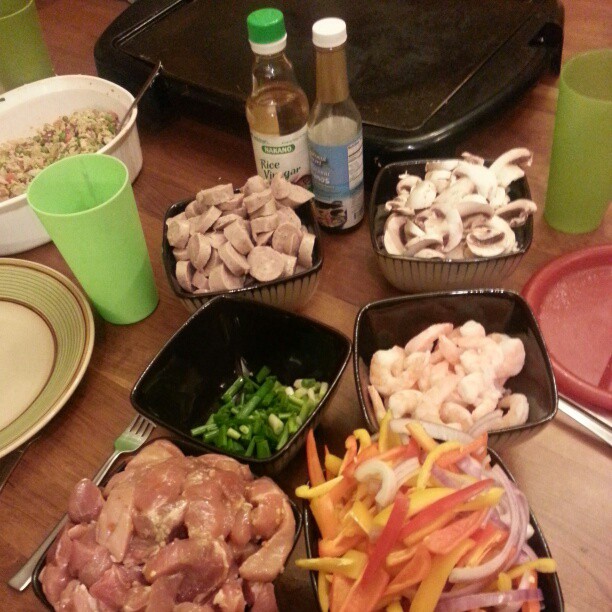
by EM2WL | Mar 3, 2014 | Consistency, Fat Loss / Cutting, Motivation, Nutrition

Combining family and fitness
Trust me, as a busy momma of five children I understand that feeding a family, presents its own unique challenges. When you are working towards eating for your fitness goals, that can be even more challenging. And if you throw an food-allergic child or two into the mix, things really get interesting!
For years, I allowed these challenges to overwhelm me to the point that I figured there was no way I could possibly lose weight or become fit. I allowed excuse after excuse to creep in, and eventually just stopped trying. Years later, I came to a point where I realized that my excuses finally caught up to me. I had to make a way to embrace my challenges and succeed in the midst of them.

2010 – I’m smiling, but can remember dreading getting family pictures done because I hated the way that I looked. My life has completely turned around!
I’ve been at this for about three years now. After struggling to lose weight despite being on one diet right after the other, I learned that our whole family needed to embrace the changes that I was attempting to undertake. Fortunately, I am blessed with a great support system in my husband and children. Today, all of us are healthier, more active, and happier. Instead of looking at this like a diet, our whole family’s lifestyle changed.
Over the past three years, I have emphasized eating for different goals including powerlifting performance, weight loss, muscle gain, and fat loss. However, our family’s approach to eating has remained fairly consistent.
Below are a few things I’ve learned along the way…
Ditch the Diet Mentality

This sure doesn’t look like a diet to me! Big breakfasts are something our family loves to enjoy together.
There’s no reason that you should have to prepare separate meals for you and your children.
Even if you’re eating enough calories, preparing separate meals tends to make you feel like you’re on a diet. This feeling of mental restriction may actually trigger binge eating.
With a little recipe tweaking, even kid-pleasing family favorites like pizza, tacos and spaghetti can be included into your weekly meal rotation. Simple tweaks like adding a serving of protein, adding more veggies, or trying out a healthier twist on a recipe can ensure that you are hitting your macros. Get creative in the kitchen!
Have a weekly meal plan and stick to it
This can be as detailed as you want! To begin with, I’d recommend coming up with a list of weekly dinners. It may be helpful to ask for some input from your family as you are coming up with your list. I usually keep a list of meals on the refrigerator, and will sometimes ask my family which meal sounds best to them in the morning.

The good, the bad, and the ugly…a typical trip to the grocery store includes lots of whole foods, and plenty of treats too!
If you’re stuck in a cooking rut, you might check out our Pinterest boards for some healthy alternatives to family favorites. Your local library probably has some great cookbooks that you can check out for some new ideas. Trying out a new recipe once a week can be a fun family adventure, and may lead to coming up with some new recipes!
If you are home all day with young children, it may be helpful to come up with a list of breakfasts and lunches that they can select from. Keep some options for easy meals on hand, and as they get older, allow them some freedom to make choices and prepare their own lunches or breakfasts. It’s a great lesson in responsibility. As a homeschool mom whose kids seem to always be hungry, this has been a huge time-saver for me. Now that my oldest three are 13, 11, and 10, they are pretty self-sufficient and usually select pretty healthy meals for themselves.
After you’ve come up with your meal list for the week, make your grocery list so that you have everything on hand you need for a successful week of cooking (and eating).
Plan a day for food prep
After your trip to the grocery store, it may be helpful to do a little food prep make the cooking process a bit faster.
S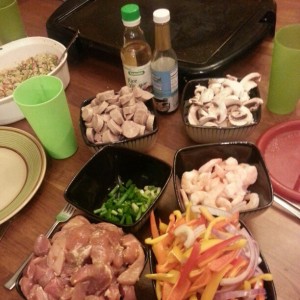 ince you already have all the groceries out, why not take a few extra minutes to think about the meals you have planned for the week ahead. It only takes a few extra minutes after you get home from the store to cut and bag fresh veggies, cook up and freeze some hamburger meat for soups and casseroles, or separate foods into single-serving containers.
ince you already have all the groceries out, why not take a few extra minutes to think about the meals you have planned for the week ahead. It only takes a few extra minutes after you get home from the store to cut and bag fresh veggies, cook up and freeze some hamburger meat for soups and casseroles, or separate foods into single-serving containers.
I like to do this on grocery shopping day because there are already so many things to put away! I usually prep a few casseroles for the freezer to give myself some quick grab-and-go meals for those busy nights when I don’t have a lot of extra time. I also tend to cook extra meats, rice, potatoes , or vegetables when I am already cooking so that I can re-purpose the leftovers into a whole other meal. Thinking ahead can save a lot of time in the long run!
Don’t keep self-sabotaging foods in the house
At EM2WL, we are all about including all foods into your healthy eating plan. Nothing is off limits! That being said, however, many of us have foods that tend to be triggers to throw caution to the wind. It’s important for each of us to recognize our limits in this department. Keeping a lot of highly processed snack foods in the house “for the kids” may be a recipe for disaster if you are prone to occasional binges. Trust me, the kids will be okay without keeping them in the house. Help them to come up with healthier alternatives for snacks instead! Know yourself and your limits.
Involve your kids in the kitchen
Getting your kids interested in eating healthfully can be as simple as inviting them into the kitchen.

Even my youngest loves brussel sprouts…and dark chocolate chips too…OF COURSE!
Not only does getting them in the kitchen teach them math skills, responsibility, and nutrition, it can also be a fun time spent just with you. Even very young children can help measure ingredients, pour, and stir together a recipe. An older child can be taught to make an entire recipe by themselves and will get tons of satisfaction proclaiming they made dinner “all by myself”! Spending time in the Besides, they are much more likely to try something different if they have helped you prepare it!
Take the time to educate your children about the importance of including all kinds of foods as part of a healthy and balanced diet. These important life skills will serve them well their whole lives!
Don’t completely eliminate treats
Having a moderate and balanced approach to all foods, including treats, is an important part of any successful approach to eating.
Food is fuel, but it is also an important part of our family get-togethers and celebrations. Plan on including some mini-indulgences in your eating plan now and then.
Bake some cookies with your kids. Enjoy a cupcake guilt-free at your little girl’s birthday party. Have a few slices of pizza during family movie night. Enjoy the freedom to pursue your health and fitness goals without sacrificing your sanity! This isn’t a diet, but a lifestyle. Consistency matters! Make choices that allow you to win at consistency.
Becca is a busy wife and homeschooling mother to five children ages 5 to 13. About three years ago, she embarked on a journey to health and fitness that resulted in the loss of approximately 100 pounds. Today, she is a competitive powerlifter and strongwoman who loves ice cream and deadlifts. As an ISSA certified personal trainer, she is passionate about helping women to get started on a lifestyle of strength and fitness.

by EM2WL | Jan 27, 2014 | Consistency, Fat Loss / Cutting, Motivation, Nutrition, Self Acceptance

Many people start their new year off strong, dedicated to the goals they set. In the beginning, when your willpower is strong, it’s easy to make those changes for a happier, healthier and more active version of yourself.
But let’s face it. Life is very rarely a smooth journey. If you live in the real world, there are plenty of road blocks and obstacles along the way. How you approach difficulty is going to make a huge difference in where you are in regards to your fitness goals a month, six months, or a year from now.
Some obstacles are foreseeable. For these, it’s important to have a plan of attack. What will your biggest obstacle be? Do you struggle to find time to get in a workout? Is it difficult for you to remain consistent with your eating? Are you challenged to get enough sleep? Think about your options and write down a concrete plan in your fitness journal. You may decide to wake up early to make it to the gym before the day’s obligations overwhelm you, or spend a Sunday afternoon prepping food for the week ahead. Decide to set yourself up for success by coming up with a concrete plan that will carry you through those times when willpower is fading fast.
1. Redefine healthy eating.
At EM2WL, we emphasize not viewing your life as being “on track” and “off track.” One of the greatest added benefits of fueling to lose is that you are taking in sufficient calories so you can plan for that piece of birthday cake or special date-night dinner. Special treats can and should be incorporated into any healthy eating plan. Rethink “healthy!” Your healthy eating plan should be the one that will help you to reach your goals, taking into account the challenges and obstacles that you face. Taking in sufficient calories to support your activity level and planning for consistency should be a major consideration.
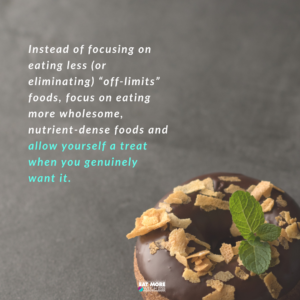 We are inundated with messages and lists of foods that are “good” and “bad.” Let’s be realistic though, no one can exist forever on a diet of coconut oil, kale, and chicken breast. Your healthy eating plan should be such that it accommodates real life-birthdays, holidays, date nights. Food is a part of many of our celebrations and should be enjoyed (in moderation, of course)!
We are inundated with messages and lists of foods that are “good” and “bad.” Let’s be realistic though, no one can exist forever on a diet of coconut oil, kale, and chicken breast. Your healthy eating plan should be such that it accommodates real life-birthdays, holidays, date nights. Food is a part of many of our celebrations and should be enjoyed (in moderation, of course)!
It requires a major shift in your mental paradigm to accept that things we’ve labeled “bad”-things like sugar, carbs, and gluten can be a part of eating for your goals. Instead of focusing on eating less (or eliminating) “off-limits” foods, focus on eating more wholesome, nutrient-dense foods and allow yourself a treat when you genuinely want it.
2. Forgive yourself!
Everyone who has been successful at making health and fitness a lifestyle knows that they can’t be perfect all the time. There will be times you overdo it on sweets, or miss one too many workouts. Do not beat yourself up! If you feel like you’ve veered off track, determine to just move on right from where you are. One or two days that are less-than-perfect are not going to spoil your long-term success, but don’t let a couple bad days turn into a week or a month. There is no reason to stress out over choices you’ve made that are in the past, or attempt to undo the damage. Instead, review your fitness goals and your motivation for making this change. Revisit your plan and stick to it. Is there something you could do differently in the future to prevent future slip-ups? Look at these slip-ups as learning experiences to prepare you for the obstacles and challenges you will run into in the future.
3. Strive for progress, not perfection.
Perfection can be the enemy of progress. Many people look at making healthy changes with an all-or-nothing approach. Too often, a minor slip-up can lead to an all-out binge as you figure, “Oh well, I’ve already blown it.” Perfect adherence to your plan is nearly impossible. Instead, strive to make progress each day. In the end, you will find that small changes are more sustainable over the long-term. Consistency is essential for success.
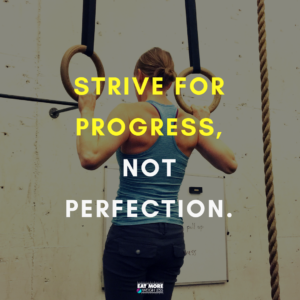 4. Look at slip-ups as learning experiences.
4. Look at slip-ups as learning experiences.
Slip-ups can be a great learning tool! Not every slip-up can be prevented, and sometimes you truly need to just put the past in the past and move on. But you may be able to look at a situation and come up with a future plan of attack. Are you more prone to binge on sweets when you are overtired? Make it a point to turn off the TV an hour earlier so you can get adequate rest. Lacking motivation after work to make it to the gym? Consider waking up early to get your workout in first thing in the morning. Struggling to make healthy choices on your lunch break? Spend a Sunday afternoon doing some food prep so you can have some easy grab-and-go choices.
5. Remember, it’s a marathon, not a sprint.
In our fast-paced society, its tempting to want to see quick results. Remember that you are creating healthy habits that will change your lifestyle. Be patient with yourself and be committed to trusting the process! This doesn’t happen overnight. Just keep moving forward, and you will be amazed when you look back and discover the healthy habits you have established are about as second-nature as brushing your teeth!
If you are not a part of our Free Online Community, you are missing out on a ton of great support and tips to help you along your journey. Join us Today!
Becca is a busy wife and homeschooling mother to five children ages 5 to 13. About three years ago, she embarked on a journey to health and fitness that resulted in the loss of approximately 100 pounds. Today, she is a competitive powerlifter and strongwoman who loves ice cream and deadlifts. As an ISSA certified personal trainer, she is passionate about helping women to get started on a lifestyle of strength and fitness.

 If someone would have told me 20 years ago that I needed to increase my caloric intake by 30% to lose body fat, I would have laughed while continuing to lace up my Mizuno running shoes preparing for my hour long run. Now 5 kids later, a little older and a little wiser, with decades of trial and error underneath my belt, eating more to weigh less has been a key factor in my fitness journey.
If someone would have told me 20 years ago that I needed to increase my caloric intake by 30% to lose body fat, I would have laughed while continuing to lace up my Mizuno running shoes preparing for my hour long run. Now 5 kids later, a little older and a little wiser, with decades of trial and error underneath my belt, eating more to weigh less has been a key factor in my fitness journey. It was not until “my plan” to reach my “goal weight” by my 38th birthday came to a halt when my body reached homeostasis. I had reached a plateau in my weight loss journey and I was no longer losing fat, or gaining muscle. I was starving, exhausted and my body was at a complete standstill. Exasperated and feeling defeated, I went back to the drawing board to research fat loss remembering all the while Becca’s encouragement to eat more. Becca introduced me to a website for calculating calories. After spending some time on this website, I was shocked at the advice given. Based on my height, weight and activity level, I needed to be consuming 30% more calories. This line of thinking was so shocking and it went against every principle “I thought” I knew about losing weight.
It was not until “my plan” to reach my “goal weight” by my 38th birthday came to a halt when my body reached homeostasis. I had reached a plateau in my weight loss journey and I was no longer losing fat, or gaining muscle. I was starving, exhausted and my body was at a complete standstill. Exasperated and feeling defeated, I went back to the drawing board to research fat loss remembering all the while Becca’s encouragement to eat more. Becca introduced me to a website for calculating calories. After spending some time on this website, I was shocked at the advice given. Based on my height, weight and activity level, I needed to be consuming 30% more calories. This line of thinking was so shocking and it went against every principle “I thought” I knew about losing weight. The number on the scale temporarily went up, but then my weight leveled out. One of the first physical changes I observed was my lack of hunger, increased energy level as well as the change in my body composition. My cellulite and fat began to diminish and I could see I was building muscle to form shape to my body. These major changes finally allowed me to feel more comfortable with my body.
The number on the scale temporarily went up, but then my weight leveled out. One of the first physical changes I observed was my lack of hunger, increased energy level as well as the change in my body composition. My cellulite and fat began to diminish and I could see I was building muscle to form shape to my body. These major changes finally allowed me to feel more comfortable with my body.
 Becca is a busy wife and homeschooling mother to five children ages 5 to 13. About three years ago, she embarked on a journey to health and fitness that resulted in the loss of approximately 100 pounds. Today, she is a competitive powerlifter and strongwoman who loves ice cream and deadlifts. As an ISSA certified personal trainer, she is passionate about helping women to get started on a lifestyle of strength and fitness.
Becca is a busy wife and homeschooling mother to five children ages 5 to 13. About three years ago, she embarked on a journey to health and fitness that resulted in the loss of approximately 100 pounds. Today, she is a competitive powerlifter and strongwoman who loves ice cream and deadlifts. As an ISSA certified personal trainer, she is passionate about helping women to get started on a lifestyle of strength and fitness.






















 We are inundated with messages and lists of foods that are “good” and “bad.” Let’s be realistic though, no one can exist forever on a diet of coconut oil, kale, and chicken breast. Your healthy eating plan should be such that it accommodates real life-birthdays, holidays, date nights. Food is a part of many of our celebrations and should be enjoyed (in moderation, of course)!
We are inundated with messages and lists of foods that are “good” and “bad.” Let’s be realistic though, no one can exist forever on a diet of coconut oil, kale, and chicken breast. Your healthy eating plan should be such that it accommodates real life-birthdays, holidays, date nights. Food is a part of many of our celebrations and should be enjoyed (in moderation, of course)! 4. Look at slip-ups as learning experiences.
4. Look at slip-ups as learning experiences.
Recent Comments